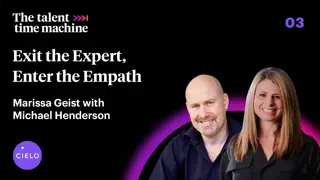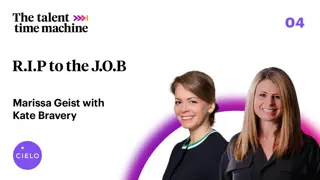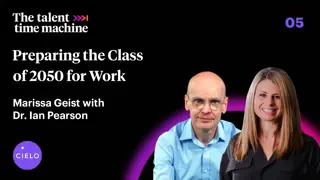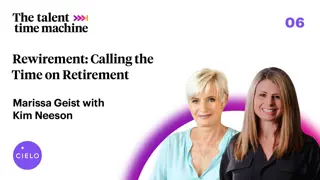What does the future hold?
It’s the golden question, but one that nobody can answer for sure. However, using data, expertise, and a little creativity, we can peer into the mist and start to build a useful picture of what’s coming.
In episode one of “The talent time machine” podcast, CEO Marissa Geist spoke to futurist Reanna Browne about how we can change the way we think about the future of our businesses and careers:
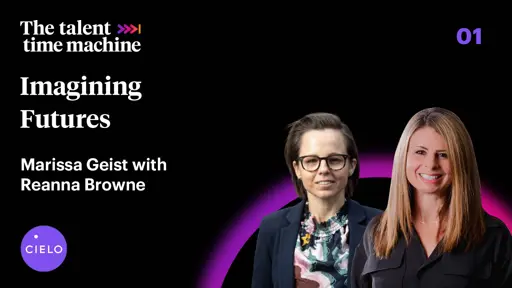
Editor’s note: This interview has been edited for clarity and brevity.
What’s the benefit of looking so far ahead when planning cycles tend to be 2, 3 or 5 years?
Reanna: We can use the idea about the future to rethink action in the present. When we don't look forward, we end up in a cycle of the current dilemmas repeating themselves. I talk about a 10-year minimum to lift our gaze from the current dilemmas. It's not about what's happening in the year 2032. It's really saying: “what is possible with this problem over 10 years? And how might we bring those possibilities into how we respond today?”
Marissa: Often, the hard things are not worth doing unless you at least take a five-year view. When we're talking about talent challenges, we won't see those things for five to seven years. To take action ahead of that requires a longer view, and not everyone's brave enough to step into that conversation. Sometimes it's easier do the things that we did before to just survive instead of really differentiate.
If you have a 10-year minimum view, how do you mitigate fear?
Reanna: I think the more stress we're under, the more narrow our view becomes. Everything in front of you seems much more important than contemplating five or 10 years down the track. If we lift our gaze a little bit to say, how can we draw on an adjacent possible here? And how can that help us challenge our assumptions and ask different questions about how we're framing the problem? The big shift is that we can use the future to help respond to these big dilemmas in the present.
How do we think about a future where a lot of “talent” won’t even be human?
Reanna: One of the signals of change lately is a shift in language to a personification of technology. The notion of bots in the workplace, for instance, was once a very tech-based conversation, but in the last two years it's started to shift to a workforce conversation. We're starting to talk about the idea of “non-human resources” inside a workforce conversation. For me, that's a really powerful shift.
Marissa: We can fully automate almost everything in the recruitment process at this point, and we’ve even experimented with it. But people didn't show up to interviews because they hadn’t spoken to a human. So, we actually had to insert an “inefficiency” to the process, getting a recruiter to make a human connection. And three times the number of people showed up because they felt like someone cared. So, there is that humanization, and we can't get too far away from it. We have to pull it back to our human core to make the process relevant and valuable for everyone.
Reanna: I love that example. I always talk about the idea of small bets and a longer game. We need to do the core foundational work, but at the same time, we're seeing automation, AI, changes in talent. And you've just described a beautiful way to bring in a small bet to test and learn. Immediately we start to get a sense of where critical human touch points are in this process. It’s a brilliant way to keep the lights on and design a more viable future in the present.
CieloWe can fully automate almost everything in the recruitment process … [But] we have to pull it back to our human core to make the process relevant and valuable for everyone.
How do you get people to digest the ideas they’ve come up with and make them real in the present?
Reanna: When things feel too far out from the present, we tend to ignore them. We can't maintain all the insights about all the possibilities, so showing evidence of change that's occurring now is a powerful way of saying “this isn't speculative.”
The conversation around change is not just to end with change, it's to say: “what's one small thing that we can start to do in response to this potential change come Monday?” And sometimes we just want to keep an eye on this, or we should start researching more about this topic?
How do we get better at standing in the future?
How do we know that we're doing it well?
Reanna: We've been taught the future is something that's out there but never arrives, because we're always in the present. It actually happens via the things that we do or don’t do today, so we need to flip the way that we think about it.
This work is not about trying to get the future precisely right. We can step away and ask questions like “what's changing, what's changed in the past, and what do we want to change going forward?” We can have a bit of agency.
We can also make this work small and integrated into our everyday conversations. I use the rule of three strikes, where the third time I've heard a trend or a topic, I pay attention. I'm always scanning for signals of change.
The other big thing to consider is a Professor Jim Dator quote, saying that any useful statement about the future should at first appear ridiculous. Otherwise, it's just a projection of today. How do we entertain futures that appear ridiculous at first, but when you go to an adjacent organization or a different sector, it's their everyday practice? Epidemiologists are a perfect example. For years, they were talking about a pandemic, but it wouldn't have been in many business plans. But for the epidemiologists, it was not a ridiculous future. It was probably inevitable.
Marissa: One of the interesting conundrums that we face and when we talk about longer term thinking is that the average tenure of entry level employees is less than one year. It's this sort of amoebic like state where people are moving from entity to entity. Will organizations even exist in 2050? Is there a company or is it just a sort of hive of work and skills that come together to assemble and disassemble? So in that case, it might be relevant for us to talk about the 2050 strategy, because we might all end up working together anyway. It’s fascinating to think that far out.
How do you bring agency into the conversation versus just speculating and reacting?
How do you change the language to be more proactive?
Reanna: I think if we can reframe it to the notion that the future doesn't exist and we have capacity to shape the future via the present. Talent acquisition is the canary in the coal mine. It’s in between the organizations and workers, collecting signals of change about how things are shifting in real time.
Marissa: I think a recruiter on the frontline would say that they are the first to hear about things, whether it's a change or trend. And we were the first people to hear that people didn't want full-time jobs, yet they were looking for more flexible employment. And people were asking “what's the reason that you exist?” So, those early signs of people wanting more flexibility from their job.
We're also the people that reported back to say we're getting triple the applicant flow if you just make jobs remote, but they're also asking if there's an office they can go into. It's those nuances that it's really tough to capture in a study or a survey. People want to work for a company that thinks about choices, flexibility, not one size fits all. That’s what we're seeing in the talent space.
Work FuturesTalent acquisition is the canary in the coal mine. It’s in between the organizations and workers, collecting signals of change about how things are shifting in real time.
With so much disruption in the world of work, how can we, as individuals, be better futurists?
Reanna: We have to shift toward an approach of sense and respond, looking to say: I'm starting to anticipate there's some shifts around automation, AI technology. Can I start researching pathways into very different industries or jobs? Can I start to think about short courses to learn more about a topic?
I think about the analogy of a plane. If the plane is shifting in its trajectory by two or three degrees, in the short term, it doesn't make a lot of difference. But over the long term, you arrive somewhere different at the end.
What are your parting thoughts?
Reanna: Firstly, I think lifting our gaze far beyond the present. That's a powerful technique that helps us see totally new ways of thinking about things. It's less about what might happen in the year 2050 and more about how does that framing shift our view of the present and what we need to do?
I also like the idea of small bets because the future feels big. What are the very small things that we can do come Monday? For me, that's a way to build agency and pathways.
And the last thing is habit stacking. Have conversations with our teams and think: where can we fold in a quick conversation about the future? If we were thinking about a ridiculous future for this topic, what would that look like? And is there any evidence of that in the present?
You don't need to be a futurist. We all have innate foresight capacity. So I think it's leaning on that, and really integrating it into the everyday flow of our work.
About the experts
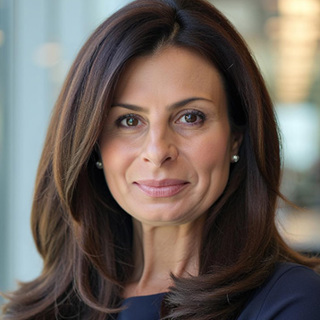
Chief Executive Officer, Cielo
Marissa is the Chief Executive Officer of Cielo, the world’s leading global talent acquisition partner. She joined Cielo in 2015 as Senior Vice President of Global Operations, where she was instrumental in scaling Cielo’s delivery model.
LinkedIn connect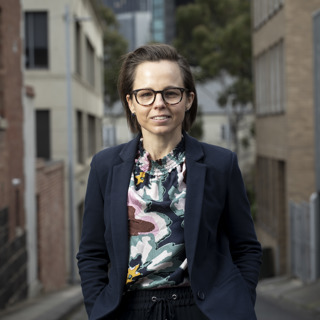
Founder, Work Futures
Reanna is an academically trained and practicing futurist, industry fellow, strategic workforce planner, start-up co-founder, keynote speaker, creative practitioner and former elite athlete.
LinkedIn connect
